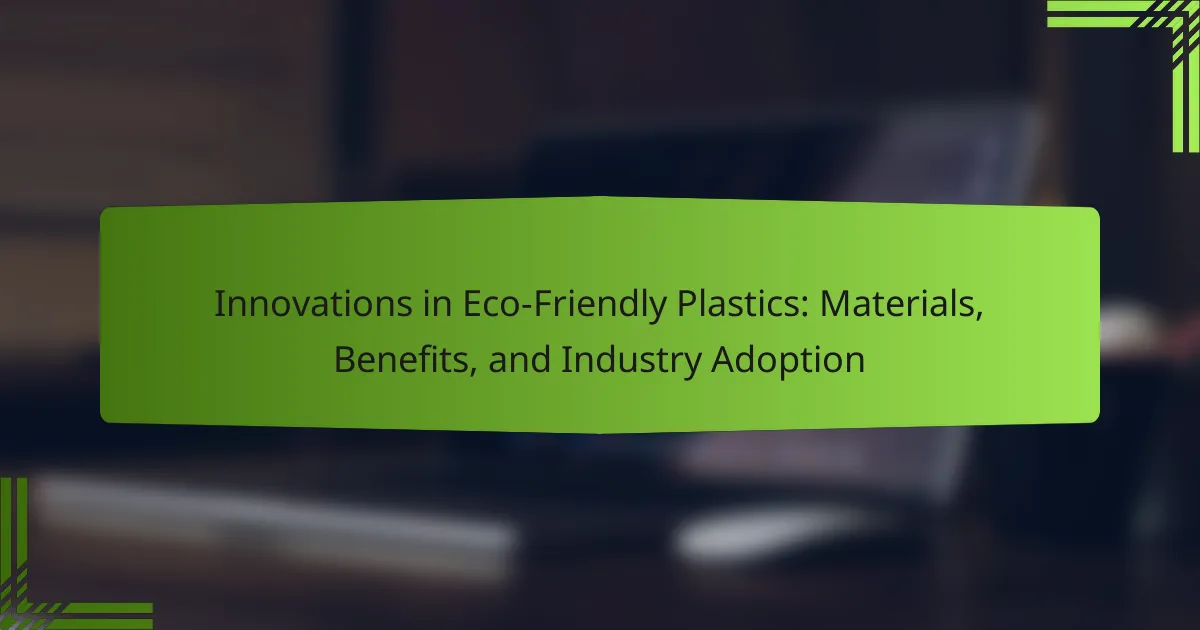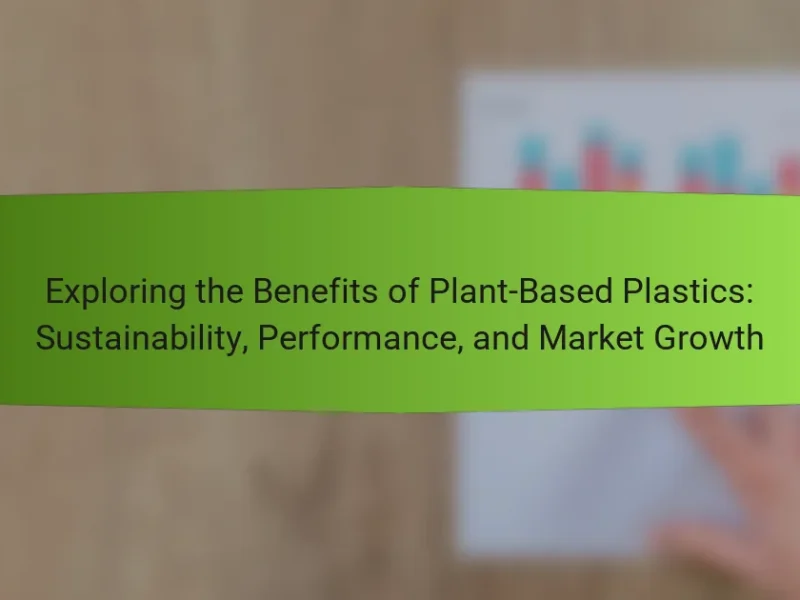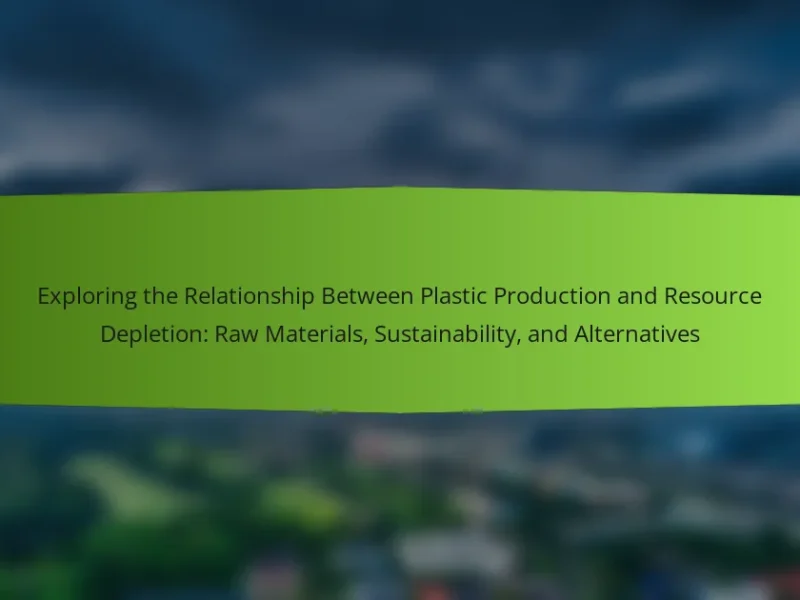Innovations in eco-friendly plastics encompass bioplastics, biodegradable materials, and recycled content, all aimed at reducing environmental impact and promoting sustainability. Bioplastics, derived from renewable resources such as corn starch and sugarcane, decrease reliance on fossil fuels and lower carbon emissions. Biodegradable materials naturally break down, while recycled content repurposes waste to minimize landfill use. The industry is increasingly adopting these materials, driven by consumer demand for sustainable products and regulatory compliance. Major brands are committing to eco-friendly practices, with advancements in processing techniques enhancing the performance and durability of these innovative plastics. The global bioplastics market is projected to reach $44 billion by 2026, reflecting a significant shift towards a circular economy.

What are Innovations in Eco-Friendly Plastics?
Innovations in eco-friendly plastics include bioplastics, biodegradable materials, and recycled content. Bioplastics are derived from renewable sources like corn starch and sugarcane. They reduce dependence on fossil fuels and lower carbon emissions. Biodegradable materials break down naturally, minimizing environmental impact. Recycled content in plastics repurposes waste materials, reducing landfill use. Advanced processing techniques improve the performance and durability of these materials. Innovations also involve developing additives that enhance biodegradability without compromising plastic properties. Research indicates that the global bioplastics market is expected to reach $44 billion by 2026. These innovations contribute to a circular economy and promote sustainable practices in various industries.
How are eco-friendly plastics different from traditional plastics?
Eco-friendly plastics differ from traditional plastics primarily in their composition and environmental impact. Eco-friendly plastics are made from renewable resources or biodegradable materials. Traditional plastics are typically derived from petroleum and are not biodegradable.
The production of eco-friendly plastics often results in lower greenhouse gas emissions compared to traditional plastics. For instance, biodegradable plastics can decompose in a composting environment within a few months, while traditional plastics can take hundreds of years to break down.
Additionally, eco-friendly plastics are designed to reduce pollution and waste. Many eco-friendly options are recyclable or compostable, whereas traditional plastics often end up in landfills or oceans, contributing to environmental degradation.
These differences highlight the growing shift towards sustainable materials in response to climate change and pollution concerns.
What materials are used in the production of eco-friendly plastics?
Eco-friendly plastics are primarily produced using renewable materials. Common materials include corn starch, sugarcane, and cellulose. These bioplastics are derived from natural sources. They are designed to be biodegradable or compostable. Other materials used are recycled plastics, which reduce waste. Some eco-friendly plastics also incorporate natural fibers like hemp or jute. These alternatives help lower carbon footprints. Studies show that bioplastics can reduce greenhouse gas emissions by up to 80% compared to conventional plastics.
What are the environmental impacts of using eco-friendly plastics?
Eco-friendly plastics significantly reduce environmental impacts compared to traditional plastics. They often biodegrade more quickly, minimizing long-term pollution. For instance, some biodegradable plastics can decompose in a matter of months under proper conditions. This contrasts with conventional plastics, which can persist in the environment for hundreds of years.
Additionally, eco-friendly plastics are typically made from renewable resources, such as corn or sugarcane. This reduces dependence on fossil fuels and lowers greenhouse gas emissions during production. Research shows that using bioplastics can cut carbon emissions by up to 80% compared to petroleum-based plastics.
Moreover, eco-friendly plastics can contribute to less waste in landfills. As they break down more efficiently, they help alleviate the burden of plastic waste. This shift towards sustainable materials fosters a circular economy, promoting recycling and reusability.
Why are innovations in eco-friendly plastics important?
Innovations in eco-friendly plastics are important because they address environmental concerns associated with traditional plastic use. Eco-friendly plastics reduce pollution and waste in landfills and oceans. They are often made from renewable resources, decreasing reliance on fossil fuels. Innovations lead to biodegradable options that break down naturally, minimizing long-lasting environmental impact. For instance, studies show that biodegradable plastics can decompose in months compared to centuries for conventional plastics. Furthermore, advancements in eco-friendly plastics can improve recycling rates and processes, making waste management more efficient. These innovations also cater to consumer demand for sustainable products, driving market growth. Hence, they play a crucial role in promoting a circular economy and sustainable development.
How do eco-friendly plastics contribute to sustainability?
Eco-friendly plastics contribute to sustainability by reducing environmental impact and promoting resource conservation. These materials are often made from renewable resources, such as cornstarch or sugarcane. They can biodegrade more efficiently than traditional plastics, minimizing landfill waste. Research indicates that biodegradable plastics can break down in a matter of months under the right conditions. Additionally, eco-friendly plastics often require less energy to produce, leading to lower carbon emissions. Studies show that using bioplastics can decrease greenhouse gas emissions by up to 80% compared to conventional plastics. By promoting recycling and reducing reliance on fossil fuels, eco-friendly plastics support a circular economy. This shift helps protect ecosystems and conserve biodiversity.
What role do eco-friendly plastics play in reducing pollution?
Eco-friendly plastics significantly reduce pollution by being biodegradable and made from renewable resources. Traditional plastics can take hundreds of years to decompose, contributing to land and ocean pollution. In contrast, eco-friendly plastics break down more quickly, minimizing their environmental impact. They often release fewer harmful chemicals during production and degradation. Research indicates that biodegradable plastics can reduce landfill waste by up to 30%. Additionally, using plant-based materials reduces reliance on fossil fuels. This shift helps lower carbon emissions associated with plastic production. Overall, eco-friendly plastics play a crucial role in mitigating pollution and promoting sustainability.

What are the benefits of using eco-friendly plastics?
Eco-friendly plastics reduce environmental impact by being biodegradable or recyclable. They help decrease plastic pollution in oceans and landfills. Many eco-friendly plastics are made from renewable resources, such as corn starch or sugarcane. This reduces reliance on fossil fuels. Studies show that using these materials can lower greenhouse gas emissions by up to 70%. Additionally, eco-friendly plastics can improve brand image as consumers increasingly prefer sustainable products. They also comply with regulations aimed at reducing plastic waste. Overall, eco-friendly plastics offer both environmental and economic benefits.
How do eco-friendly plastics benefit manufacturers?
Eco-friendly plastics benefit manufacturers by reducing production costs and enhancing brand reputation. These materials often require less energy to produce compared to traditional plastics. This reduction in energy use can lead to lower operational expenses. Additionally, eco-friendly plastics can attract environmentally conscious consumers. This consumer preference can drive sales and market share. Furthermore, manufacturers may benefit from government incentives for using sustainable materials. These incentives can include tax breaks or grants. Studies show that companies adopting eco-friendly practices often see improved customer loyalty and brand image.
What cost savings can be achieved through the use of eco-friendly plastics?
Eco-friendly plastics can lead to significant cost savings in various industries. These savings primarily arise from reduced material costs and energy consumption during production. For example, bio-based plastics often utilize renewable resources, which can lower raw material expenses. Additionally, eco-friendly plastics typically require less energy to manufacture compared to traditional petroleum-based plastics.
Research indicates that companies adopting eco-friendly materials can see a decrease in waste disposal costs. This is due to the biodegradable nature of many eco-friendly plastics, leading to lower landfill fees. Furthermore, businesses may benefit from government incentives for using sustainable materials.
In a study by the Ellen MacArthur Foundation, it was found that transitioning to a circular economy, which includes the use of eco-friendly plastics, could save global businesses up to $1 trillion by 2025. These factors collectively demonstrate that eco-friendly plastics not only support environmental sustainability but also significantly enhance cost efficiency for companies.
How do eco-friendly plastics enhance brand reputation?
Eco-friendly plastics enhance brand reputation by aligning with consumer values for sustainability. Brands that adopt these materials demonstrate environmental responsibility. This commitment can lead to increased customer loyalty. Studies show that 66% of consumers are willing to pay more for sustainable products. Eco-friendly practices also attract environmentally conscious customers. Additionally, brands using sustainable materials can differentiate themselves in competitive markets. Positive media coverage often follows companies that innovate in eco-friendly solutions. This visibility further strengthens brand image and reputation.
What advantages do eco-friendly plastics offer to consumers?
Eco-friendly plastics provide consumers with several advantages. They are often biodegradable, reducing environmental impact. These materials typically require less energy to produce than traditional plastics. Eco-friendly plastics can also be sourced from renewable materials, promoting sustainability. Additionally, they contribute to a reduction in carbon emissions. Many eco-friendly plastics are designed to be recyclable, enhancing waste management. Consumers may also benefit from improved safety, as these plastics often contain fewer harmful chemicals. Overall, eco-friendly plastics align consumer choices with environmental responsibility.
How do eco-friendly plastics affect consumer choices?
Eco-friendly plastics positively influence consumer choices by aligning with environmentally conscious values. Consumers increasingly prefer products that reduce environmental impact. A survey by Nielsen found that 73% of millennials are willing to pay more for sustainable brands. This trend indicates a shift towards eco-friendly options in purchasing decisions. Additionally, brands using eco-friendly plastics often enhance their market appeal. Companies that adopt sustainable practices can attract a loyal customer base. Therefore, eco-friendly plastics significantly shape consumer preferences and drive market trends.
What health benefits are associated with eco-friendly plastics?
Eco-friendly plastics offer several health benefits. They reduce exposure to harmful chemicals found in traditional plastics. Many eco-friendly options are made from natural materials, minimizing toxic substances. These plastics often contain fewer additives, such as phthalates and bisphenol A (BPA). Lower levels of these chemicals can lead to decreased health risks, including hormonal disruptions and reproductive issues. Additionally, eco-friendly plastics are often biodegradable or compostable. This reduces environmental pollution, which can indirectly benefit public health. Studies indicate that using safer materials can lead to healthier living environments. Overall, eco-friendly plastics promote both individual and environmental health.

How is the industry adopting eco-friendly plastics?
The industry is adopting eco-friendly plastics through various strategies and innovations. Companies are investing in bioplastics made from renewable resources such as corn starch and sugarcane. These materials are designed to be biodegradable or compostable, reducing environmental impact. Major brands are committing to using recycled plastics in their products. For example, Coca-Cola aims to use 50% recycled content in its PET plastic bottles by 2030. Additionally, manufacturers are developing new technologies to improve the performance of eco-friendly plastics. This includes enhancing durability while maintaining sustainability. The shift towards eco-friendly plastics is also driven by consumer demand for sustainable products. According to a 2021 survey, 66% of global consumers are willing to pay more for sustainable brands. This growing trend indicates a significant transformation in industry practices towards more eco-conscious solutions.
What are the current trends in eco-friendly plastic adoption?
Current trends in eco-friendly plastic adoption include increased use of biodegradable materials, such as polylactic acid (PLA) and polyhydroxyalkanoates (PHA). Many companies are shifting towards plant-based plastics to reduce reliance on fossil fuels. There is a growing emphasis on recycling and circular economy practices in the industry. Brands are implementing take-back programs to encourage consumer participation in recycling. Innovations in chemical recycling technologies are gaining traction, allowing for more efficient processing of plastic waste. The demand for eco-friendly packaging solutions is rising among consumers, leading to greater market availability. Regulatory pressures are also influencing companies to adopt sustainable practices. These trends reflect a broader commitment to environmental sustainability and reducing plastic pollution.
Which industries are leading the way in adopting eco-friendly plastics?
The packaging, automotive, and consumer goods industries are leading the way in adopting eco-friendly plastics. The packaging industry is focusing on biodegradable and compostable materials to reduce waste. Automotive manufacturers are incorporating recycled plastics to enhance sustainability. Consumer goods companies are shifting towards plant-based plastics for product packaging and containers. These industries are responding to increasing consumer demand for sustainable products. According to a report by Grand View Research, the global biodegradable plastics market is expected to reach $6.9 billion by 2025, indicating significant growth in eco-friendly plastic adoption.
What challenges do companies face when transitioning to eco-friendly plastics?
Companies face several challenges when transitioning to eco-friendly plastics. High production costs are a significant barrier. Eco-friendly materials often require more expensive raw materials and processes. Limited availability of sustainable alternatives can hinder supply chain logistics. Companies may also struggle with the lack of consumer awareness regarding eco-friendly options. This can lead to lower demand for these products. Additionally, regulatory compliance can be complex and varies by region. Companies must navigate different environmental regulations and standards. Performance issues may arise, as some eco-friendly plastics do not match the durability of traditional plastics. This can affect product quality and consumer satisfaction. Overall, these challenges create a complicated landscape for companies aiming to adopt eco-friendly plastics.
How can businesses successfully implement eco-friendly plastics?
Businesses can successfully implement eco-friendly plastics by adopting sustainable materials and practices. They should prioritize bioplastics made from renewable resources, such as corn starch or sugarcane. These materials reduce reliance on fossil fuels. Companies can also invest in recycling technologies to enhance the lifecycle of plastics. Implementing a closed-loop system can minimize waste and promote reusability.
Additionally, businesses need to educate consumers about the benefits of eco-friendly plastics. Providing transparent information on sourcing and production processes builds trust. Collaborating with suppliers committed to sustainability ensures a consistent supply of eco-friendly materials.
Research indicates that the global bioplastics market is projected to reach $44 billion by 2024, reflecting growing consumer demand. This trend highlights the importance of adopting eco-friendly practices for long-term viability.
What best practices should companies follow when adopting eco-friendly plastics?
Companies should prioritize sourcing sustainable materials when adopting eco-friendly plastics. This includes selecting bioplastics made from renewable resources. Companies must also conduct life cycle assessments to evaluate environmental impacts. Implementing efficient recycling processes is essential for reducing waste. Collaborating with suppliers to ensure transparency in sourcing is crucial. Educating consumers about the benefits of eco-friendly plastics can drive adoption. Setting measurable sustainability goals helps track progress. Finally, staying informed about regulations and innovations in the eco-friendly materials sector is vital.
How can businesses measure the impact of eco-friendly plastics on their operations?
Businesses can measure the impact of eco-friendly plastics on their operations through several key metrics. They can track cost savings associated with reduced waste disposal fees. Additionally, companies can assess changes in customer satisfaction and brand perception due to sustainable practices. Measuring the reduction in carbon footprint is also crucial. Businesses should analyze lifecycle assessments of eco-friendly plastics compared to traditional materials. They can monitor compliance with environmental regulations and certifications. Finally, evaluating sales growth in products made with eco-friendly plastics provides insight into market acceptance. These metrics collectively illustrate the operational impact of eco-friendly plastics.
What future innovations can we expect in eco-friendly plastics?
Future innovations in eco-friendly plastics include bioplastics made from renewable resources. These materials aim to reduce dependence on fossil fuels. Advanced recycling technologies will enhance the lifecycle of plastic products. Chemical recycling methods can break down plastics into their original monomers. This allows for the creation of new, high-quality plastics. Innovations in biodegradable additives will improve the decomposition rate of conventional plastics. Smart materials that change properties based on environmental conditions are also being developed. Research into algae-based plastics is gaining traction, offering a sustainable alternative. These advancements are crucial for reducing plastic waste and environmental impact.
How are researchers exploring new materials for eco-friendly plastics?
Researchers are exploring new materials for eco-friendly plastics by investigating biopolymers and natural fibers. They are focusing on materials derived from renewable resources like corn, sugarcane, and algae. These materials can decompose more easily compared to traditional plastics. For example, polylactic acid (PLA) is a popular biopolymer made from corn starch. Researchers also examine the potential of integrating additives that enhance biodegradability. Studies show that these innovations could significantly reduce plastic waste in landfills. The use of cellulose-based materials is another area of interest. These materials can provide similar properties to conventional plastics while being more sustainable. Overall, the exploration of these materials aims to create a circular economy for plastics.
What technological advancements are shaping the future of eco-friendly plastics?
Biodegradable polymers and bio-based plastics are technological advancements shaping eco-friendly plastics’ future. These materials reduce reliance on fossil fuels and enhance sustainability. Innovations include advancements in polylactic acid (PLA) production, which utilizes renewable resources like corn starch. Another development is the use of enzymatic recycling processes, allowing plastics to be broken down and reused efficiently. Additionally, researchers are exploring the integration of nanotechnology to improve the properties of bio-based plastics. These advancements are supported by studies showing that bio-based plastics can significantly lower carbon emissions. For instance, a report from the European Bioplastics Association highlights that bioplastics can reduce greenhouse gas emissions by up to 80% compared to conventional plastics.
What practical steps can consumers take to support eco-friendly plastics?
Consumers can support eco-friendly plastics by choosing products made from biodegradable or recycled materials. They should look for certifications indicating sustainable practices. Avoiding single-use plastics is essential. Instead, opt for reusable items like bags and containers. Participating in local recycling programs helps reduce plastic waste. Supporting brands that prioritize eco-friendly practices encourages industry change. Educating others about the benefits of eco-friendly plastics promotes wider adoption. According to the Ellen MacArthur Foundation, transitioning to a circular economy can significantly reduce plastic pollution.
Innovations in eco-friendly plastics focus on materials such as bioplastics, biodegradable substances, and recycled content, which significantly reduce environmental impact compared to traditional plastics. Key benefits include lower greenhouse gas emissions, enhanced biodegradability, and contributions to a circular economy. The article explores how these materials are produced, their environmental effects, and the advantages they offer to manufacturers and consumers. Additionally, it examines industry adoption trends, challenges faced during the transition, and future innovations in eco-friendly plastics. Overall, the content emphasizes the importance of sustainable practices in addressing pollution and promoting resource conservation.


